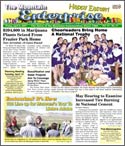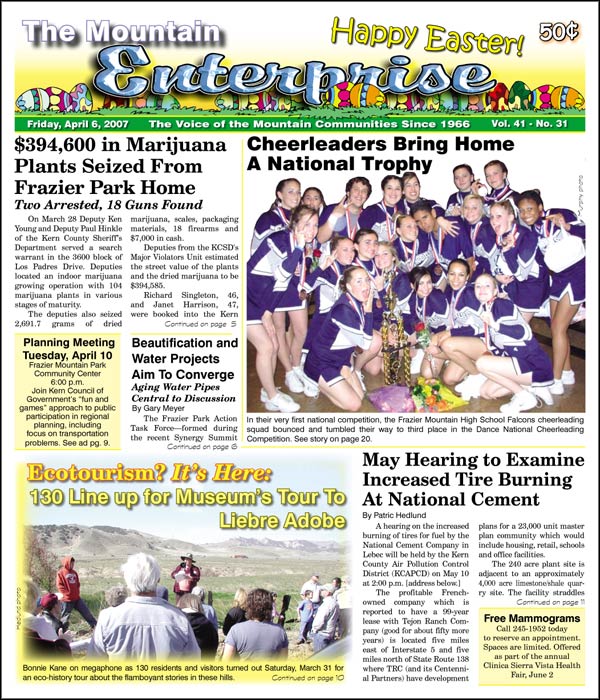By Patric Hedlund
A hearing on the increased burning of tires for fuel by the National Cement Company in Lebec will be held by the Kern County Air Pollution Control District (KCAPCD) on May 10 at 2:00 p.m. [address below.]
The profitable French-owned company which is reported to have a 99-year lease with Tejon Ranch Company (good for about fifty more years) is located five miles east of Interstate 5 and five miles north of State Route 138 where TRC (and its Centennial Partners) have development plans for a 23,000-unit master planned community to include housing, retail, light industrial, schools and office facilities.
The 240 acre National Cement plant site is adjacent to a 4,000 acre limestone/shale quarry site. The facility straddles the line between Kern and Los Angeles Counties, but its emissions permits are fully within the Kern County Air Pollution Control District’s jurisdiction.
The plant was built in the mid 1960s, just in time to supply cement for the building of the Interstate 5 freeway and the California Aqueduct system that runs through Tejon Ranch to supply water to the sprawlng population of Los Angeles.
In the eyes of many mountain residents, the plant has a troubling past, stemming from local concerns in the 1980s that fuels were being burned in the plant’s kilns that created significant toxic emissions, blowing toward Mountain Communities homes.
From 1984 through October 2004, the National Cement Company paid about $1.5 million in fines for violations associated with releasing excess toxic emissions into the air, according to a document released by the KCAPCD. In 2003, the U.S. Environmental Protection Agency levied an $838,396 fine for excess emission of nitrous oxide (NOX), sulfur oxide (SOX) and carbon monoxide (CO). This week, a $15,000 fine is being proposed by KCAPCD for excess particulates coming from storage piles at the site.
In an interview Tuesday, April 3, Air Pollution Control Officer David L. Jones said he has been strictly monitoring the plant and applying additional safety requirements when infractions arise.
Jones explained the agency’s findings from a year-long air-flow study showing that "because the plant is in a valley, most emissions go along the ridge up the valley toward Gorman and Lebec or down the other way into the Antelope Valley, toward Mojave and Palmdale. The big ridge behind the plant holds much of the emissions from going toward the site for the planned Tejon Mountain Village, although there are a couple of ranch sites [in that project] that concerned us. The Centennial City site was also part of our EIR check in 2004, and it looks okay."
The environmental impact report (EIR) was required when National Cement first sought to permission for their ‘Tires for Fuel’ project. Although the current federal administration’s Environmental Protection Agency did not require additional study when National Cement requested to increase tire burning to equal 50% of their total fuel in 2007, Jones said, the local Kern County Air Pollution Control District did require an addendum to the 2004 EIR. KCAPCD mandated the additional testing to learn if there are increased health hazards associated with increased use of tires as fuel.
"Our risk factors are calculated on the basis of someone being exposed to the sampled level of emissions for 70 years," he explained. "The air pollution control board has adopted a stricter risk threshold than the federal government. The federal EPA uses a ‘one to ten new cancer’ threshold. We use the stricter standard adopted by most agencies in California. Our ‘unacceptable risk’ threshold at KCAPCD is 1.0—one new cancer death per million people."
"We have done new health modeling in the 2007 addendum to the EIR," Jones explained, adding "If you have ever seen an open pile of burning tires, you know that stuff is nasty and it is a real health hazard…but that is not what is happening here."
He described significant increases in monitoring and accountability measures which are being applied by KCAPCD to keep National Cement within compliance, including close monitoring of temperatures in both kilns and baghouses (filter arrays where particulates are scrubbed from smoke).
Jones said the most recent studies regarding increasing the amount of tires used for fuel "show there is no increase in risk to the public," according to the series of tests run by the agency.
Before the Tire for Fuel program began, tests run in 2002 showed a .99 risk factor, "just below our 1.0 threshold," the KCAPCD executive said. The latest tests, run in early February 2007, meaured emissions using the proposed increased levels of shredded tires as fuel. "Our preliminary results indicate that the risk is now .9, slightly below the 2002 ‘pre-tires as fuel’ level," Jones reported.
The May 10 hearing will be held at the Rosamond Community Service District office (3179 35th Street West, Rosamond, California 93560). To see the EIR and new health addendum reports, go to www.kernair. org. Click on 2007 Addendum, National Cement Project.
This is part of the April 06, 2007 online edition of The Mountain Enterprise.
Have an opinion on this matter? We'd like to hear from you.


